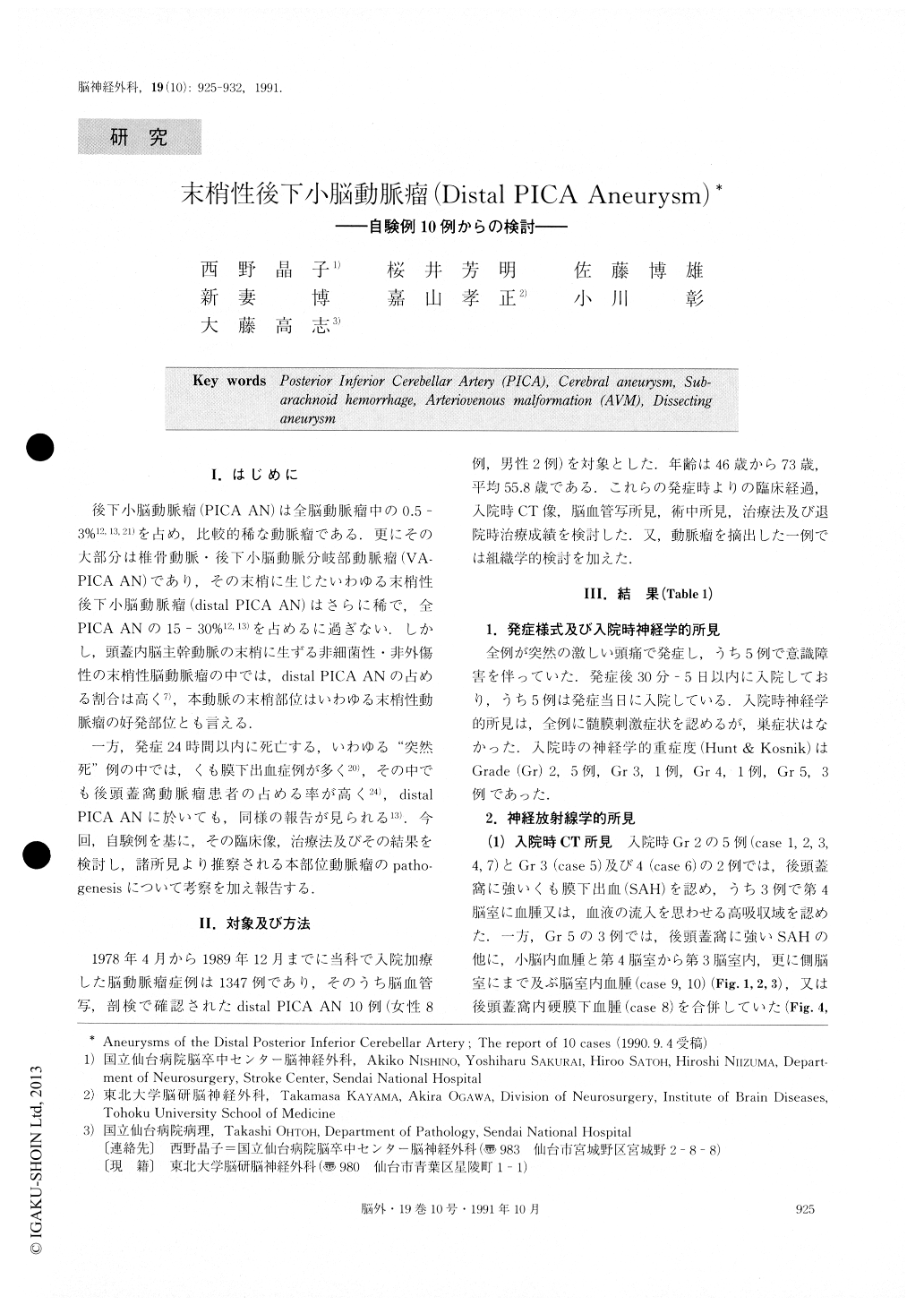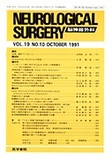Japanese
English
- 有料閲覧
- Abstract 文献概要
- 1ページ目 Look Inside
I.はじめに
後下小脳動脈瘤(PICA AN)は全脳動脈瘤中の0.5—3%12, 13, 21)を占め,比較的稀な動脈瘤である.更にその大部分は椎骨動脈・後下小脳動脈分岐部動脈瘤(VA—PICA AN)であり,その末梢に生じたいわゆる末梢性後下小脳動脈瘤(distal PICA AN)はさらに稀で,全PICA ANの15-30%12,13)を占めるに過ぎない.しかし,頭蓋内脳主幹動脈の末梢に生ずる非細菌性・非外傷性の末梢性脳動脈瘤の中では,distal PICA ANの占める割合は高く7),本動脈の末梢部位はいわゆる末梢性動脈瘤の好発部位とも言える.
一方,発症24時間以内に死亡する,いわゆる“突然死”例の中では,くも膜下出血症例が多く20),その中でも後頭蓋窩動脈瘤患者の占める率が高く24),distalPICA ANに於いても,同様の報告が見られる13).今回,自験例を基に,その臨床像,治療法及びその結果を検討し,諸所見より推察される本部位動脈瘤のpatho—genesisについて考察を加え報告する.
Abstract
Non mycotic and non traumatic distal posterior in-ferior cerebellar artery (PICA) aneurysms are rare, but eleven aneurysms in ten cases were reported. They alloriginated from subarachnoid hemorrhage due to rup-ture of these aneurysms. The patients in these cases were all admitted within 5 days after the onset. The neurological state of four cases on admission was grade 4 or 5 in Hunt and Kosnik's grading system. Two pa-tients of grade 5 died within 24 hours after the onset.
The CT scan on admission revealed heavy subarach-noid hemorrhage mainly in the posterior fossa. In se-vere cases, ventricle hematoma, cerebellar hematoma and/or subdural hematoma were evident in the pos-terior fossa.
The locations of these eleven aneurysms were as follows : On the bifurcation of the Telovelotonsillar segment in six cases. In the cortical segment in three cases. In the anterior medullary and tonsillomedullary segment in one case. Six saccular aneurysms were situ-ated on bifurcations of parent arteries but three saccu-lar aneurysms did not arise from bifurcations. Two of them were not from turning points of the arteries. One fusiform aneurysm situated on the bifurcation oftelovelotonsillar segment was excised, and histological-ly shown to be a dissecting aneurysm with hypoplasia of elastic lamina and tunica media in the parent artery. Three cases were associated with small AVM located on the superior surface of the cerebellar vermis and fed mainly by the superior cerebellar artery (SCA) in two cases, and by SCA and PICA in one case. In these cases the hemodynamic stress on PICA did not seem to increase so remarkably. From these findings it was sug-gested that, in the pathogenesis of distal PICA aneurysms congenital factors would be as influential as the increase of hemodynamic stress.
Seven cases were treated surgically and three were treated conservatively. The management results on dis-charge were as follows : good recovery in six cases, moderately disability in two, and death in two. These results showed that the prognosis for ruptured distal PICA aneurysms was not so good as previously reported.

Copyright © 1991, Igaku-Shoin Ltd. All rights reserved.


